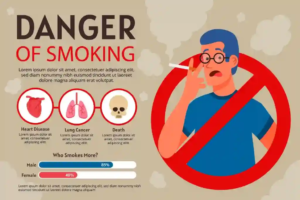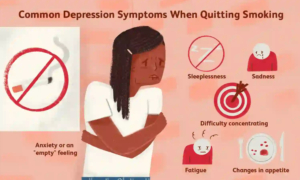 Quitting smoking is one of the most life-changing decisions a person can make for their health. It is a journey that involves not only physical challenges but also mental, emotional, and behavioral transformations. Many people desire to quit smoking, yet they often feel unprepared for the withdrawal symptoms and side effects that come after their last cigarette. In this detailed article, we will explore the short-term and long-term side effects of quitting smoking, how these changes affect the body, and ways to manage them.
Quitting smoking is one of the most life-changing decisions a person can make for their health. It is a journey that involves not only physical challenges but also mental, emotional, and behavioral transformations. Many people desire to quit smoking, yet they often feel unprepared for the withdrawal symptoms and side effects that come after their last cigarette. In this detailed article, we will explore the short-term and long-term side effects of quitting smoking, how these changes affect the body, and ways to manage them.
We will also explain the role of nicotine, withdrawal, cravings, and treatment methods such as nicotine replacement therapy. By the end, you will have a clear understanding of what to expect, how to cope, and how to support others or yourself in becoming smoke-free.
Understanding Smoking and Its Impact on the Body
Before diving into the side effects of quitting smoking, it is essential to understand how tobacco and nicotine affect the body. Cigarettes, e-cigarettes, and nicotine pouches introduce addictive substances into the bloodstream that alter brain chemistry, heart rate, blood pressure, and lung function.
Tobacco use contributes to many serious health problems, including heart disease, lung cancer, and chronic respiratory illnesses. According to the American Cancer Society, smoking is responsible for about 30% of all cancer deaths in the United States. It also plays a central role in the development of coronary heart disease, high blood pressure, and stroke.
The First Step: The Last Cigarette
For many people, the most difficult part is putting down the last cigarette. That single act, however, sets in motion a cascade of positive changes in the body. Within just 20 minutes of quitting, heart rate and blood pressure begin to drop. Oxygen levels in the blood start to return to normal within 12 hours as carbon monoxide clears from the system.
But this first day also brings the onset of withdrawal symptoms. Many people experience intense cravings, anxiety, and restlessness. These symptoms are part of nicotine withdrawal, which can begin as soon as a few hours after the last puff.
Common Withdrawal Symptoms and Their Timeline
 Within the First Few Days
Within the First Few Days
Nicotine withdrawal symptoms typically peak in the first week and may include:
- Irritability and mood swings
- Headaches and dizziness
- Difficulty concentrating
- Increased appetite and weight gain
- Anxiety and restlessness
- Coughing and sore throat as the lungs begin to clear mucus
- Sleep disturbances
These symptoms are part of the body’s natural recovery process. As nicotine levels drop, the brain adjusts to functioning without it.
First Week to Few Weeks
During the first week, both physical and psychological symptoms can be intense. Many people feel overwhelmed, which is why support and planning are vital. By the end of the second or third week, however, symptoms generally begin to ease.
Physical symptoms such as coughing, mucus production, and headaches may reduce. Some may experience increased fatigue as the body rebalances. Emotional symptoms like depression and irritability can persist but will gradually improve.
First Few Months
Within two to three months, lung function improves significantly. Oxygen levels increase, and circulation returns to normal. People often report increased energy and the ability to engage in physical activity without shortness of breath.
This is also the time when psychological symptoms like depression, anxiety, or cravings may return unexpectedly. These episodes can be triggered by stress, social situations, or memories linked to smoking. This is why having a solid quit plan and support system is essential.
Psychological and Emotional Side Effects
Quitting smoking affects not only the body but also the brain. Nicotine stimulates dopamine release, which contributes to feelings of pleasure and stress relief. Without it, many people experience psychological symptoms like:
- Depression
- Anxiety
- Irritability
- Mood fluctuations
- Difficulty concentrating
These side effects can be intense, especially for those with underlying mental health conditions. It is critical to work with a healthcare provider if symptoms persist. Support groups and therapy can also be highly beneficial.
Physical Side Effects and Health Improvements
 Despite the discomfort of withdrawal, quitting smoking brings tremendous health benefits. Even as the body experiences temporary side effects, healing begins:
Despite the discomfort of withdrawal, quitting smoking brings tremendous health benefits. Even as the body experiences temporary side effects, healing begins:
- Improved lung function: Coughing decreases, mucus clears, and the bronchial tubes begin to repair.
- Heart health improves: Blood pressure normalizes, heart rate decreases, and the risk of heart attack lessens.
- Circulation improves: With better oxygen levels and clearer blood vessels, physical stamina increases.
- Cancer risk drops: The risk of developing cancers related to smoking, including lung, cervical, and mouth cancers, begins to decline.
Less Common Side Effects
Weight Gain
One common concern is weight gain after quitting. Nicotine suppresses appetite and increases metabolism. Without it, people may eat more or crave high-calorie foods.
To manage this, incorporate physical activity into your daily routine. It supports overall health and helps counteract weight gain.
Vivid Dreams and Sleep Issues
Some people report unusual dreams or insomnia. These are temporary and typically resolve in a few weeks.
Skin Breakouts or Digestive Changes
The body goes through a detox process, and for some, this leads to mild digestive issues or acne. Staying hydrated and eating a balanced diet can help alleviate these symptoms.
Different Paths to Quit Smoking
Each person’s journey is unique. What works for one may not work for another. There are several ways to approach smoking cessation:
Cold Turkey
Quitting cold turkey means stopping all at once without aids. While effective for some, it can lead to intense cravings and withdrawal symptoms.
Nicotine Replacement Therapy (NRT)
This includes nicotine gum, nicotine pouches, patches, lozenges, and sprays. These help manage cravings and reduce withdrawal by gradually tapering off nicotine dependence.
Prescription Medications
Medicines such as varenicline (Chantix), bupropion (Wellbutrin or Aplenzin), and others are available. These can help reduce cravings and manage depression or anxiety.
Behavioral Support and Therapy
Counseling, group therapy, and quit-smoking programs provide psychological support. Many people find success through guided treatment and personalized quit plans.
Alternative Approaches
Options like hypnosis to quit smoking may benefit some individuals. These methods tap into subconscious behavior and may support traditional cessation strategies.
Cannabis and Marijuana Withdrawal
For some, quitting smoking may also involve marijuana or cannabis cessation. While different in chemical structure, marijuana also leads to dependency in some users. Symptoms of cannabis withdrawal include:
- Anxiety
- Irritability
- Insomnia
- Reduced appetite
- Restlessness
As with nicotine, withdrawal effects subside over time with support and treatment.
Long-Term Benefits and Lifestyle Changes
The long-term effects of quitting smoking are overwhelmingly positive. After a year, the risk of heart disease drops to half that of a smoker. After five years, the risk of stroke and several cancers significantly decreases. After ten years, the risk of lung cancer drops by nearly half.
Beyond physical health, people experience improvements in:
- Mental clarity and emotional well-being
- Social relationships
- Financial savings
- Overall quality of life
Support Systems and Healthcare Providers
Quitting smoking is not a solitary journey. Involving a healthcare provider ensures that you receive medical advice, prescriptions if needed, and tailored support.
Support groups, both online and in person, offer encouragement and accountability. Many platforms help individuals create profiles, track progress, and share milestones with others.
The Quit Smoking Community is a valuable blog resource offering advice, personal stories, and guidance without promoting commercial products. You can also explore evidence-based quitting help and emotional support through Smokefree.gov, a trusted, non-commercial site backed by health experts.
Final Thoughts
Experiencing withdrawal symptoms and side effects after quitting smoking is entirely normal. These challenges are signs that your body is healing from years of nicotine dependence and tobacco exposure. Though the first days and weeks may be difficult, the long-term health benefits far outweigh the temporary discomfort.
If you’re considering quitting smoking or supporting someone on this journey, remember that education, preparation, and support are the keys to success. Whether you go cold turkey, use nicotine replacement therapy, or explore alternative methods, the goal is a healthier, smoke-free life.Your health is worth it, and the first step can begin today.






